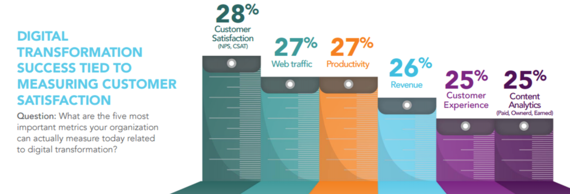Executives not investing in understanding their customer struggle to understand their behaviour
"The #1 challenge facing executives (71%) is understanding behavior or impact of the new customer. Yet, only half (54%) of survey respondents have completely mapped out the customer journey. This means that many companies are changing without true customer-centricity."
“Another top challenge facing digital transformation is the very thing that governs the course of business: a culture that is pervasively risk-averse (63%). Boards, shareholders, and stakeholders want to make improvements and increase profitability but are often unwilling to examine and change the governance in place today,” said Solis.

Additionally, the ROI of digital transformation is reflected in employee morale. In that regard, 37% of respondents stated that second to increased market share, employee engagement was the next big return.
2016 State of digital transformation | Huffington Post | Valan Afshar, Sept. 2016
It is challenging to receive negative feedback but is often worth it.
People tend to move away from those who provide feedback that is more negative than their view of themselves. They do not listen to their advice and prefer to stop interacting with them altogether. It seems that people tend to strengthen their bonds with people who only see their positive qualities.
It is natural property of your confirmation bias to seek praise and avoid criticism. However, some exposure to dissenting and critical views can help you improve your approach and open up new avenues of thinking.
Bot fighting and infinite automated feedback loops oh my
Interesting as you may have noticed bots are becoming more mainstream. In Government you have the ATO's chatbot and in Fintech ANZ and others bringing them in to assist with first tier customer service.
They have also been used on Wikipedia and for microtrading in Financial markets. When they work well they deliver a lot of benefits but when they are left unchecked for a while then they can get stuck in infinite loops and create overhead.
I sometimes see this effect played out on a smaller level with ghost cron jobs left running on a server.
I think bots and accompanying ai and machine learning activities are going to be very interesting to watch this year.
Technical debt and design debt covered nicely
Technical debt
Debt is acquired by building for the short-term. The interest accrued is the amount of time to manage, repair, rewrite, and build upon the poorly written and designed code.
Design debt
Design debt is acquired by design teams creating non-reusable solutions for isolated problems. Design debt is made up of an over abundance of non-reusable and inconsistent styles, treatments, and interactions and the interest is the impossible task of their management and modification.
We have seen our design debt impact usability and performance of our site.